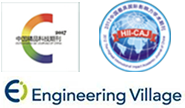Mechanical properties of polyimide surface treated glass fiber/epoxy resin composites
-
摘要: 采用浇铸成型工艺制备含0.5wt%、长度分别为1 mm、3 mm、5 mm的短切玻璃纤维/环氧树脂(GF/EP)复合材料,研究含活性酚羟基和不含酚羟基的两种聚酰亚胺(PI)处理GF表面对纤维束拉伸强度及GF/EP复合材料力学性能的影响,并进一步研究PI处理GF对复合材料热性能的影响。研究结果表明,经过PI处理的GF,集束性和拉伸强度得到提高。含活性酚羟基聚酰亚胺(PI1)处理的GF拉伸强度由原丝束的517 MPa提高到1 032 MPa,不含酚羟基聚酰亚胺(PI2)处理的GF提高到986 MPa。当PI1处理的GF长度为3 mm时,GF/EP复合材料的力学性能最好,拉伸强度比未处理的提高23.62%,拉伸模量提高34.03%,弯曲强度提高28.74%,断裂韧性提高13.04%;PI2处理的GF,GF/EP复合材料拉伸强度提高15.87%,拉伸模量提高23.70%,弯曲强度提高14.11%,断裂韧性提高4.05%。此外,PI处理GF对GF/EP复合材料热性能也有一定程度的提高。Abstract: The short glass fiber/epoxy resin (GF/EP) composites with 0.5wt% GF were fabricated through casting method. The properties of GF/EP composites length 1 mm, 3 mm and 5 mm were studied, respectively. The mechanical properties and thermal properties of GF/EP composite and the tensile strength of the fiber tow with surface treatment of polyimide (PI) were investigated. Polyimides with reactive phenolic hydroxyl groups (PI1) and without (PI2) were prepared. The results show that tensile strength and strand integrity of the GF are improved. The tensile strength of GF treated with PI1 is increased from 517 MPa to 1 032 MPa and PI2 is increased to 986 MPa. GF/EP composites have the best mechanical properties when 3 mm GF treated with PI1, and tensile strength, tensile modulus, flexural strength and fracture toughness of PI1-GF/EP composites are increased by 23.62%, 34.03%, 28.74% and 13.04% respectively. The mechanical properties of GF/EP composites with treatment of PI2 are slightly improved. The tensile strength, tensile modulus, flexural strength and fracture toughness are increased by 15.87%, 23.70%, 14.11% and 4.05%, respectively. The glass transition temperature of PI2-GF/EP composite is significantly improved by treating GF with PI.
-
Keywords:
- glass fibers /
- surface treatment /
- epoxy resin /
- polyimide /
- mechanical properties
-
-
期刊类型引用(12)
1. 贾宝惠,任鹏,宋挺,崔开心,肖海建. 湿热环境下端径比对复合材料螺栓连接结构静力拉伸失效的影响. 材料导报. 2024(05): 246-252 .  百度学术
百度学术
2. 张宇,郭盼盼,熊婕,黄峰,王波. 循环湿热环境对树脂基复合材料弯曲性能的影响. 科学咨询(科技·管理). 2024(02): 135-138 .  百度学术
百度学术
3. 牛存洋,寿文凯,顾海萍,孔德良. 以价值观为导向的生态学课程思政教学设计——以种群生活史对策为例. 科学咨询(教育科研). 2024(03): 134-137 .  百度学术
百度学术
4. 刘鸿森,黄凯,黄金钊,韩晓剑,逯浩,骆杨,张莉,果立成. 考虑温度效应的复合材料紧固结构面外拉脱性能和失效机制. 复合材料学报. 2024(09): 4778-4790 .  本站查看
本站查看
5. 王慧敏,任亮,范微微,陈阳,孙丽. 基于锥体结构复合材料制品布带缠绕成型关键工艺参数优化. 宇航材料工艺. 2024(05): 87-92 .  百度学术
百度学术
6. 樊俊铃,马国庆,焦婷,陈曾美,韩啸. 温度和湿度对碳纤维增强复合材料老化影响研究综述. 航空科学技术. 2023(09): 1-13 .  百度学术
百度学术
7. 刘宋婧,冯宇,张腾,毕亚萍,张铁军. 航空复合材料加筋板湿热环境下吸湿性能. 航空动力学报. 2023(09): 2231-2240 .  百度学术
百度学术
8. 王静,程健,肖存勇,贾松,任荣,熊需海. 先进聚合物基复合材料超声焊接研究进展. 高分子材料科学与工程. 2023(09): 166-173 .  百度学术
百度学术
9. 蒋平,吕太勇,吴丽华,José Pérez-Rigueiro,胡梦蕾,徐丽萍,黄诗怡,王安萍,郭聪. 形变导致的蜘蛛大壶状腺丝力学行为的记忆与变异. 材料导报. 2023(23): 237-245 .  百度学术
百度学术
10. 吴志猛. 聚四氟乙烯芳纶1313纤维树脂基复合材料的摩擦学性能研究. 化学工程与装备. 2022(09): 40-41+44 .  百度学术
百度学术
11. 王志平,陈灏,路鹏程. 电-湿耦合作用下碳纤维增强树脂基复合材料损伤机制. 中国塑料. 2022(10): 39-45 .  百度学术
百度学术
12. 史超帆,陈叔平,王洋,金树峰,于洋,何远新,杨帅,熊珍艳,史庆智. 纤维方向对环氧树脂/玻纤复合材料导热性能影响. 工程塑料应用. 2022(11): 108-116 .  百度学术
百度学术
其他类型引用(9)
-
计量
- 文章访问数:
- HTML全文浏览量:
- PDF下载量:
- 被引次数: 21




 下载:
下载:
